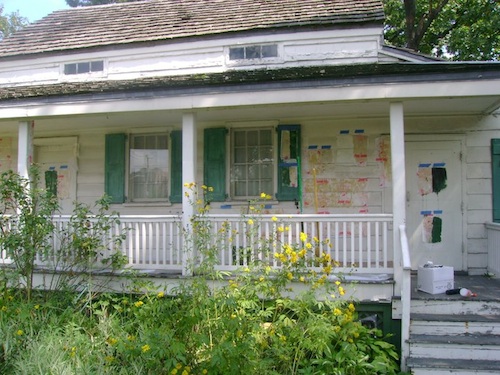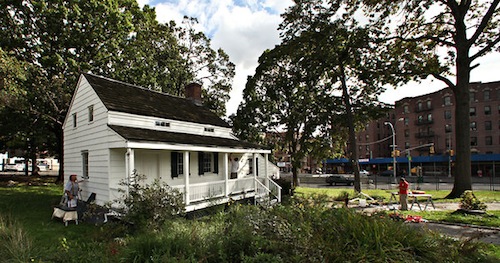Bells are ringing for Poe's renovated Bronx cottage
The New York Times looks at the New York City-owned Bronx cottage where Edgar Allan Poe wrote the poems “Annabel Lee," “The Bells” and the short story “The Cask of Amontillado." The cottage "is receiving the finishing touches of a nearly half-million dollar renovation." Before:
The article tells us that "the Poe Park Visitors Center, which sits a stone’s throw away in the adjacent playground," was also completed this year:
The iron-gray pavilion, with a V-shape roof (like the wingspan of a raven) and slate shingles to evoke feathers, was designed by the architect Toshiko Mori and is being promoted by the Bronx Historical Society as both a complement to the Poe house and “a venue with boroughwide appeal.” The new center will provide a space to show a video on Poe’s life and offer some introductory exhibits before people head over for their cottage tour.
But neither the society, which helps operate the cottage with the city, nor the Parks Department, which paid $4.5 million for the visitor center, can afford to staff the new pavilion, said Angel Hernandez, an educator with the historical society. In the middle of the day last week its public bathrooms were locked with a handwritten note that said they were under repair. The sides of the pavilion were scratched, and vandals had begun the work of prying off the slate shingles. . . .
The society has applied for grants and to foundations and the State Legislature for financing, Mr. Hernandez said, but so far has had no luck in this harsh economic climate. The idea of selling paving stones bearing the names of donors, as was done in Tompkins Park in Manhattan, was rejected by the Parks Department. Until an agreement is reached on who has responsibility for operating the center, fund-raising proposals have been postponed.
Visitors, however, are still welcome:
With the welcome center not yet opened, visitors must watch the video from some 20 metal folding chairs that crowd the cottage’s upstairs bedroom. They learn that Poe, considered America’s first lyric poet and the inventor of the modern detective story, moved to the former farmhouse in the summer of 1846 with his wife, Virginia, and her mother, Maria Clemm. He had married Virginia, his first cousin, in 1836 when she was just 13 years old.
By the time they moved to Fordham, she was suffering from tuberculosis, and Poe was bankrupt, having lost his savings in a magazine venture. His mother-in-law (and aunt) foraged in the neighboring fields for food. Virginia did not survive the winter, and contemporary visitors can see the tiny 8-by-8-foot room downstairs that contained the bed in which she died that January, in 1847.
Friends noted that Poe was crushed by her death and sat by her grave, despairing, for hours. The haunting verses of “Annabel Lee,” the last that Poe composed, relate how “all the night-tide, I lie down by the side/Of my darling — my darling — my life and my bride/In her sepulchre there by the sea.”
Poe spent many of his days in the Bronx (then considered a part of Westchester County) wandering through the woods and by the river. St. John’s College, now Fordham University, had opened just a few years before his arrival, and he frequently visited the first generation of Jesuits there, writing that they “enjoyed smoking, drinking and playing cards, and they never discussed religion.”
Poe’s fondness for alcohol was notorious, and one can imagine the clanging from the bell tower on campus, prompting him, after a night of drinking, to write, “To the tolling of the bells/Of the bells, bells, bells, bells —/Bells, bells, bells — .” The university still has the very bell, stamped 1840, though some speculate it may have been another bell in New York that haunted Poe.
Read the full article here.




